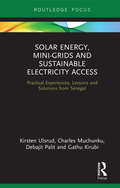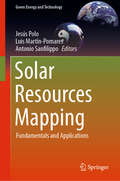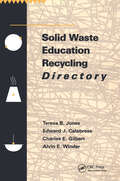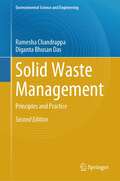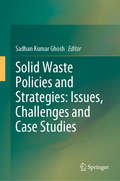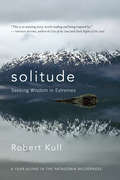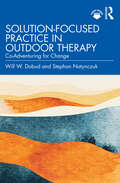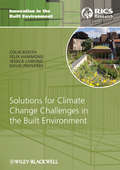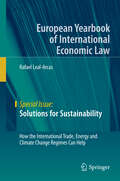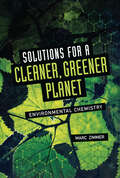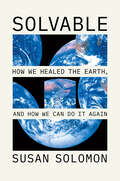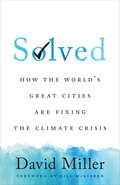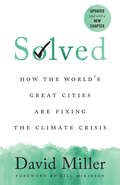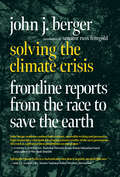- Table View
- List View
Solar Adobe: Energy, Ecology, and Earthen Architecture
by Albert NarathHow a centuries-old architectural tradition reemerged as a potential solution to the political and environmental crises of the 1970s Against the backdrop of a global energy crisis, a widespread movement embracing the use of raw earth materials for building construction emerged in the 1970s. Solar Adobe examines this new wave of architectural experimentation taking place in the United States, detailing how an ancient tradition became a point of convergence for issues of environmentalism, architecture, technology, and Indigenous resistance. Utilized for centuries by the Pueblo people of the American Southwest and by Spanish colonialists, adobe construction found renewed interest as various groups contended with the troubled legacies of modern architecture and an increasingly urgent need for sustainable design practices. In this period of critical experimentation, design networks that included architects, historians, counterculture communities, government weapons labs, and Indigenous activists all looked to adobe as a means to address pressing environmental and political issues. Albert Narath charts the unique capacities of adobe construction across a wide range of contexts, consistently troubling simple distinctions between traditional and modern technologies, high design and vernacular architecture. Drawing insightful parallels between architecture, environmentalism, and movements for Indigenous sovereignty, Solar Adobe stresses the importance of considering the history of the built environment in conjunction with architecture&’s larger impact on the natural world.
Solar Energy (Our Environment)
by Kris HirschmannHumankind's dependence on fossil fuels is depleting the Earth's resources. Solar energy is one possible solution to this problem. This book examines all aspects of the solar energy question-how solar energy works, its problems and potential, where it is being used today and more.
Solar Energy, Mini-grids and Sustainable Electricity Access: Practical Experiences, Lessons and Solutions from Senegal (Routledge Focus on Environment and Sustainability)
by Debajit Palit Kirsten Ulsrud Charles Muchunku Gathu KirubiThis book presents new research on solar mini-grids and the ways they can be designed and implemented to provide equitable and affordable electricity access, while ensuring economic sustainability and replication. Drawing on a detailed analysis of solar mini-grid projects in Senegal, the book provides invaluable insights into energy provision and accessibility which are highly relevant to Sub-Saharan Africa, and the Global South more generally. Importantly, the book situates mini-grids in rural villages within the context of the broader dynamics of national- and international-level factors, including emerging system innovation and socio-technical transitions to green technologies. The book illustrates typical challenges and potential solutions for practitioners, policymakers, donors, investors and international agencies. It demonstrates the decisive roles of suitable policies and regulations for private-sector-led mini-grids and explains why these policies and regulations must be different from those that are designed as part of an established, centralized electricity regime. Written by both academics and technology practitioners, this book will be of great interest to those researching and working on energy policy, energy provision and access, solar power and renewable energy, and sustainable development more generally.
Solar Flares: What You Need to Know
by Whitley StrieberThere is a force out there that could destroy our world in minutes. . . .Solar flares--brief bursts of radiation from our sun--have always existed and have never been particularly dangerous. Nature hasn't changed. But we have. <P><P>By making our world so dependent on electricity delivered by huge, unprotected power grids we have inadvertently placed humanity at terrible risk. As bestselling author Whitley Strieber explores in this urgent new work, a powerful solar flare could demolish our electrical delivery system, wiping away centuries of civilization in minutes and drastically changing our world.Such a scenario is altogether plausible--and it is the single most dangerous single thing that could happen to our civilization, more dangerous than the most massive earthquake or volcano, more dangerous than climate change, more dangerous even than nuclear war. What is worse, solar flares of a now-dangerous intensity are not all that uncommon; and not only that, our electrical and electronic infrastructure is becoming so extensive, and thus so fragile, that smaller and smaller solar flares can pose more and more serious hazards.<P>Due to the astonishing unwillingness of power companies to cooperate, good programs that would make us safer, and that are supported by both political parties, have been routinely prevented from being enacted.In Solar Flares: What You Need to Know, Strieber reveals the dangers behind solar flares, tracks the disastrous damage they could cause, surveys what they would do to our world in the here-and-now, and explains what nations and individuals must do to prepare for them.
Solar Powered Charging Infrastructure for Electric Vehicles: A Sustainable Development
by David Morley, Xiaoming Li, Crispin JenkinsonThe Paris Agreement on Climate Change adopted on December 12, 2015 is a voluntary effort to reduce greenhouse gas emissions. In order to reach the goals of this agreement, there is a need to generate electricity without greenhouse gas emissions and to electrify transportation. An infrastructure of SPCSs can help accomplish both of these transitions. Globally, expenditures associated with the generation, transmission, and use of electricity are more than one trillion dollars per year. Annual transportation expenditures are also more than one trillion dollars per year. Almost everyone will be impacted by these changes in transportation, solar power generation, and smart grid developments. The benefits of reducing greenhouse gas emissions will differ with location, but all will be impacted. This book is about the benefits associated with adding solar panels to parking lots to generate electricity, reduce greenhouse gas emissions, and provide shade and shelter from rain and snow. The electricity can flow into the power grid or be used to charge electric vehicles (EVs). Solar powered charging stations (SPCSs) are already in many parking lots in many countries of the world. The prices of solar panels have decreased recently, and about 30% of the new U.S. electrical generating capacity in 2015 was from solar energy. More than one million EVs are in service in 2016, and there are significant benefits associated with a convenient charging infrastructure of SPCSs to support transportation with electric vehicles. Solar Powered Charging Infrastructure for Electric Vehicles: A Sustainable Development aims to share information on pathways from our present situation to a world with a more sustainable transportation system with EVs, SPCSs, a modernized smart power grid with energy storage, reduced greenhouse gas emissions, and better urban air quality. Covering 200 million parking spaces with solar panels can generate about 1/4 of the electricity that was generated in 2014 in the United States. Millions of EVs with 20 to 50 kWh of battery storage can help with the transition to wind and solar power generation through owners responding to time-of-use prices. Written for all audiences, high school and college teachers and students, those in industry and government, and those involved in community issues will benefit by learning more about the topics addressed in the book. Those working with electrical power and transportation, who will be in the middle of the transition, will want to learn about all of the challenges and developments that are addressed here.
Solar Resources Mapping: Fundamentals and Applications (Green Energy and Technology)
by Jesús Polo Luis Martín-Pomares Antonio SanfilippoThis book presents methods for optimising the spatial and network configuration of solar radiation measuring stations. Various physical and mathematical models are demonstrated, which together with high quality measurements, provide the essential tools to generate and validate solar resource estimates to improve the mapping of solar resources.Each chapter deals with a specific topic, showing its methodology, and providing examples of how to apply these techniques with reference to current projects around the world. These topics include:· Radiometric measurement campaigns;· Equipment calibration, installation, operation, and maintenance;· Data quality assurance and assessment;· Solar radiation modelling from satellite images and numerical models;· Downscaling and kriging interpolation of solar radiation;· Simulation of electric solar power plant generation;· Solar radiation forecasting;· Applications of solar energy; and· Socio-economic benefits of solar energy.The contributors present the statistical and physical models needed to derive solar radiation from satellite images and numerical models, emphasising the importance of measuring solar radiation accurately. They also show the classical models used to generate synthetic data, clear sky models and ancillary air quality and meteorological data from different input sources.Solar Resources Mapping provides industry professionals with methodologies and tools to build solar irradiance maps for different applications. The book will also benefit students and researchers as it serves as a main technical reference, presenting the basic terminology and fundamentals for solar resource mapping that include methods for assessing measurement uncertainty.
Solastalgia: An Anthology of Emotion in a Disappearing World
by Janisse Ray Scott Russell Sanders Susan Clayton Kathryn Miles Paul Bogard Alison Hawthorne Deming Kathleen Dean Moore Sean Hill Elena Passarello Angela Pelster Genevieve Guenther Nickole Brown Meera Subramanian Ben Goldfarb Kathryn Nuernberger Sarah Jaquette Ray Joan Naviyuk Kane Priscilla Solis Ybarra J. Drew Lanham Suzanne Roberts Taylor Brorby Laura Erin England Lauren K. Alleyne Roopali Phadke Cynthia Belmont Holly Haworth Ken Hada Douglas Haynes Leah Naomi Green Jennifer Westerman Erica Cavanagh Priya Shukla Marco Wilkinson Jennifer Atkinson"One of the penalties of an ecological education," wrote Aldo Leopold, "is that one lives alone in a world of wounds." As climate change and other environmental degradations become more evident, experts predict that an increasing number of people will suffer emotional and psychological distress as a result. Many are feeling these effects already. In the pages of Solastalgia, they will find a source of companionship, inspiration, and advice.The concept of solastalgia comes from the Australian philosopher Glenn Albrecht, who describes it as "the homesickness we feel while still at home." It’s the pain and longing we feel as we realize the world immediately around us is changing, with our love for that world serving as a catalyst for action on its behalf.This powerful anthology brings together thirty-four writers—educators, journalists, poets, and scientists—to share their emotions in the face of environmental crisis. They share their solastalgia, their beloved places, their vulnerability, their stories, their vision of what we can create.
Solid Waste Education Recycling Directory
by Edward J. Calabrese Teresa JonesThis directory thoroughly describes all of the solid waste education programs and materials available from all 50 states. If you are interested in starting a solid waste recycling program or improving what you have-this directory is for you. All programs K-12 are included, in addition to information provided on the other environmental programs available. The solid waste directory gives you names, addresses, phone numbers, materials currently being used, how you can get them, how much they cost or if they are free. This book will be of great interest to city managers and planners. All cities, towns and counties will want this book!
Solid Waste Management: Principles and Practice (Environmental Science and Engineering)
by Ramesha Chandrappa Diganta Bhusan DasThis book discusses solid waste management issues from global to local level. It offers an overview of the methods and paradigms of this burgeoning field, ranging from generation, characteristics, quantity, and practical challenges. The book discusses the major issues with respect to environmental health and economy, which are related to solid waste management. Furthermore, it contains updated information on topics such as toxicology, climate change, population pressure, urbanization, energy production, building and community design, and disaster preparedness in the context of solid waste management.
Solid Waste Policies and Strategies: Issues, Challenges and Case Studies
by Sadhan Kumar GhoshThe book focuses on the challenges faced by urban areas in the context of handling waste in an environmentally and socially acceptable manner. It also discusses effective waste management approaches, which differ according to culture, climate, and socio-economic variables, as well as institutional volume. Presenting selected, high-quality papers from IconSWM 2018, the book explores a number of waste management methods with the help of case studies.
Solid, Liquid, Gassy (Fairy Science)
by Ashley SpiresEsther the fairy is back, to investigate the water cycle! From the award-winning author of The Most Magnificent Thing, for fans of Ada Twist, Scientist and Hidden Figures.Esther the fairy doesn't believe in magic. But fairies are all about magic, despite Esther's best efforts to reveal the science of their world. This time around, though, she's got her fairy pals Clover and Fig, along with trusty sidekick Albert the bird, to help create a more science-oriented entry for their school's "Magic Fair" -- Pixieville's magical answer to a science fair, which has never gone well for Esther before. When the local pond disappears, Esther realizes this might be the perfect opportunity for a real experiment! It's up to Esther and her fairymates to ask questions, make hypotheses, do research and show their conclusions -- this time, all about the water cycle. But when everyone Esther knows believes that Jack Frost is responsible for ice and that moon sneezes cause evaporation, she'll have to learn that sometimes discovery is its own reward.Solid, Liquid, Gassy (A Fairy Science Story) is the second book in Ashley Spires' hilarious picture book series about a charming, determined heroine who celebrates the joys of curiosity and wonder.
Solidarität in Zeiten multipler Krisen: Imperiale Lebensweise und Politische Bildung (Citizenship. Studien zur Politischen Bildung)
by Dirk Lange Ulrich Brand Lara KierotIn diesem Sammelband werden aus unterschiedlichen fachspezifischen, wissenschaftlichen und praktischen Perspektiven vielfältige Aspekte des Themas „Imperiale Lebensweise und Politische Bildung“ beleuchtet und kritisch reflektiert. Die didaktischen Potenziale unterschiedlicher wissenschaftlicher Herangehensweisen und Praxiserfahrungen werden vorgestellt und theoretische Überlegungen sowie empirische Erkenntnisse zum Schwerpunktthema präsentiert.
Solitude
by Robert KullYears after losing his lower right leg in a motorcycle crash, Robert Kull traveled to a remote island in Patagonia's coastal wilderness with equipment and supplies to live alone for a year. He sought to explore the effects of deep solitude on the body and mind and to find the spiritual answers he'd been seeking all his life. With only a cat and his thoughts as companions, he wrestled with inner storms while the wild forces of nature raged around him. The physical challenges were immense, but the struggles of mind and spirit pushed him even further. Solitude: Seeking Wisdom in Extremes is the diary of Kull's tumultuous year. Chronicling a life distilled to its essence, Solitude is also a philosophical meditation on the tensions between nature and technology, isolation and society. With humor and brutal honesty, Kull explores the pain and longing we typically avoid in our frantically busy lives as well as the peace and wonder that arise once we strip away our distractions. He describes the enormous Patagonia wilderness with poetic attention, transporting the reader directly into both his inner and outer experiences.
Solo
by Álvaro VizcaínoUna novela inspiradora y llena de mensajes de superación, escrita a partir de una increíble historia real de supervivencia. Isla de Fuerteventura, septiembre de 2014. En busca de la ola perfecta, un surfista se precipita por un acantilado. Sobrevive más de 48 horas perdido, con el cuerpo malherido y la cadera rota, venciendo a una naturaleza implacable y a sus propios miedos para lograr sobrevivir. Álvaro Vizcaíno transforma su increíble experiencia al borde de la muerte en una novela inspiradora y llena de fuerza. «Me di cuenta de que a todo el mundo le costaba explicarse cómo sobreviví, y de que al relatar la historia causaba una fuerte impresión a quien la escuchaba. Mis amigos me decían que iban a dejar su trabajo, o que lo habían pensado mejor y se iban a quedar con su novia, y cosas así. Parecía que mi historia era de las que marcaban un antes y un después, así que me decidí a escribirla. ¡Buen viaje y buenas olas!»Álvaro Vizcaíno
Solution-Focused Practice in Outdoor Therapy: Co-Adventuring for Change
by Will W. Dobud Stephan NatynczukSolution-Focused Practice in Outdoor Therapy presents a comprehensive model for working therapeutically with clients outdoors, with adventure, and in any outdoor setting – from a typical one-hour session to multi-day expeditions. Chapters lay out a robust and pragmatic model for opening the counseling room door using solution-focused methods. Dobud and Natynczuk bring together research on best practice in psychotherapy, monitoring therapeutic outcomes, safe and inclusive leadership, supervision, and self-care to present a robust framework for working therapeutically outdoors. Case vignettes are presented throughout the book, and a field manual is available for free download with purchase of the book.
Solutions for Climate Change Challenges in the Built Environment (Innovation in the Built Environment #11)
by Jessica Lamond Colin A. Booth David G. Proverbs Felix N. HammondThe multi-disciplinary perspective provided here offers a strategic view on built environment issues and improve understanding of how built environment activities potentially induce global warming and climate change. It also highlights solutions to these challenges. Solutions to Climate change Challenges in the Built Environment helps develop an appreciation of the diverse themes of the climate change debate across the built environment continuum. A wide perspective is provided through contributions from physical, environmental, social, economic and political scientists. This strategic view on built environment issues will be useful to researchers as well as policy experts and construction practitioners wanting a holistic view. This book clarifies complex issues around climate change and follows five main themes: climate change experiences; urban landscape development; urban management issues; measurement of impact; and the future. Chapters are written by eminent specialists from both academic and professional backgrounds. The main context for chapters is the developed world but the discussion is widened to incorporate regional issues. The book will be valuable to researchers and students in all the built environment disciplines, as well as to practitioners involved with the design, construction and maintenance of buildings, and government organisations developing and implementing climate change policy.
Solutions for Sustainability: How the International Trade, Energy and Climate Change Regimes Can Help (European Yearbook of International Economic Law)
by Rafael Leal-ArcasThis book explores links and synergies between international trade and two of the most urgent challenges of the 21st century: achieving sustainable energy (i.e., energy that is affordable, secure, and clean) and mitigating climate change. It takes the unique approach of not only examining how international trade can help achieve energy and climate goals, but also the impact of emerging tools and technologies such as smart grids and demand response, and the potential role and impact of citizens and prosumers. The book analyzes energy- and trade-related regulations in a range of jurisdictions to assess how conducive the regulation is towards achieving sustainable energy, and identifies gaps and overlaps in the existing legal framework.
Solutions for a Cleaner, Greener Planet: Environmental Chemistry
by Marc ZimmerMany of the most toxic materials on Earth—from arsenic to plutonium—occur naturally, but manufacturers have also used them in products such as paints, plumbing, pesticides, nuclear fuel, and weaponry. Without careful management, toxins can leach into groundwater or pollute our environment. Exposure to toxins leads to various cancers, impairment of the immune and reproductive systems, as well as cognitive problems. What can be done? Solutions include a wide range of infrastructure approaches, such as better water filtration, governmental and manufacturing regulations, outright bans on certain chemicals, careful monitoring, and the use of alternative fuels. Learn more about key contaminants and their impact on health, as well as solutions on a global and individual level.
Solvable: How We Healed the Earth, and How We Can Do It Again
by Susan SolomonA compelling and pragmatic argument: solutions to yesterday’s environmental problems reveal today’s path forward. We solved planet-threatening problems before, Susan Solomon argues, and we can do it again. Solomon knows firsthand what those solutions entail. She first gained international fame as the leader of an expedition to Antarctica in 1986, making discoveries that were key to healing the damaged ozone layer. She saw a path—from scientific and public awareness to political engagement, international agreement, industry involvement, and effective action. Solomon, an atmospheric scientist and award-winning author, connects this career-defining triumph to the inside stories of other past environmental victories—against ozone depletion, smog, pesticides, and lead—to extract the essential elements of what makes change possible. The path to success begins when an environmental problem becomes both personal and perceptible to the general public. Lawmakers, diplomats, industries, and international agencies respond to popular momentum, and effective change takes place in tandem with consumer pressure when legislation and regulation yield practical solutions. Healing the planet is a long game won not by fear and panic but by the union of public, political, and regulatory pressure. Solvable is a book for anyone who has ever despaired about the climate crisis. As Solomon reminds us, doom and gloom get us nowhere, and idealism will only take us so far. The heroes in these stories range from angry mothers to gang members turned social activists, to upset Long Island birdwatchers to iconoclastic scientists (often women) to brilliant legislative craftsmen. Solomon’s authoritative point of view is an inspiration, a reality check, a road map, and a much-needed dose of realism. The problems facing our planet are Solvable. Solomon shows us how.
Solved: How the World’s Great Cities Are Fixing the Climate Crisis
by David MillerIf our planet is going to survive the climate crisis, we need to act rapidly. Taking cues from progressive cities around the world, including Los Angeles, New York, Toronto, Oslo, Shenzhen, and Sydney, this book is a summons to every city to make small but significant changes that can drastically reduce our carbon footprint. We cannot wait for national governments to agree on how to reduce greenhouse gas emissions and manage the average temperature rise to within 1.5 degrees. In Solved, David Miller argues that cities are taking action on climate change because they can – and because they must. Miller makes a clear-eyed and compelling case that, if replicated at pace and scale, the actions of leading global cities point the way to creating a more sustainable planet. Solved: How the World’s Great Cities Are Fixing the Climate Crisis demonstrates that the initiatives cities have taken to control the climate crisis can make a real difference in reducing global emissions if implemented worldwide. By chronicling the stories of how cities have taken action to meet and exceed emissions targets laid out in the Paris Agreement, Miller empowers readers to fix the climate crisis. As much a "how to" guide for policymakers as a work for concerned citizens, Solved aims to inspire hope through its clear and factual analysis of what can be done – now, today – to mitigate our harmful emissions and pave the way to a 1.5-degree world.
Solved: How the World’s Great Cities Are Fixing the Climate Crisis
by David MillerIf our planet is going to survive the climate crisis, we need to act rapidly. Taking cues from progressive cities around the world, including Los Angeles, New York, Toronto, Oslo, Shenzhen, and Sydney, this book is a summons to every city to make small but significant changes that can drastically reduce our carbon footprint. We cannot wait for national governments to agree on how to reduce greenhouse gas emissions and manage the average temperature rise to within 1.5 degrees. In Solved, David Miller argues that cities are taking action on climate change because they can – and because they must. The updated paperback edition of Solved: How the World’s Great Cities Are Fixing the Climate Crisis demonstrates that the initiatives cities have taken to control the climate crisis can make a real difference in reducing global emissions if implemented worldwide. By chronicling the stories of how cities have taken action to meet and exceed emissions targets laid out in the Paris Agreement, Miller empowers readers to fix the climate crisis. As much a “how to” guide for policymakers as a work for concerned citizens, Solved aims to inspire hope through its clear and factual analysis of what can be done – now, today – to mitigate our harmful emissions and pave the way to a 1.5-degree world.
Solving the Climate Crisis: Frontline Reports from the Race to Save the Earth
by John J. BergerGroundbreaking solutions to the climate crisis from scientists, engineers, civic leaders, entrepreneurs and activists, offering hope to all readers concerned about our planet's future.Offers practical actions that reflect technological and economic advances with an introduction by former United States senator Russ Feingold.Solving the Climate Crisis is a hopeful and critical resource that makes a convincing and detailed case that there is a path forward to save our environment. Illustrating the power of committed individuals and the necessity for collaborative government and private-sector climate action, the book focuses on three essential areas:The technological dimension: move to 100% clean renewable energy as fast as we possibly can through innovations like clean-steel, &“green&” cement, and carbon-reuse companies;The ecological dimension: enhance and protect natural ecosystems, forests, and agricultural lands to safely store greenhouse gases and restore soils, transforming how we grow, process, and consume food;The social dimension: update and create new laws, policies and economic measures to recenter human values and reduce environmental and social injustice.Based on more than 6 years of research, Berger traveled the nation and abroad to interview governors, mayors, ranchers, scientists, engineers, business leaders, energy experts, and financiers as well as carbon farmers, solar and wind innovators, forest protectors, non-profit leaders, and activists.With real world examples, an explanation of cutting-edge technologies in solar and wind, and political organizing tactics, Solving the Climate Crisis provides a practical road map for how we effectively combat climate change. Replacing the fossil-fuel system with a newly invigorated, modernized, clean-energy economy will produce tens of millions of new jobs and save trillions of dollars. Protecting the climate is thus potentially the greatest economic opportunity of our time.
Som la última generació que pot salvar el planeta
by Varias autoras Carlota BrunaSom l'última generació que pot salvar el món. Som l'última generació que haurà de mirar als ulls a la següent i respondre a la pregunta: "I tu, què vas fer?". Carlota Bruna prologa i edita aquest al·legat a cinc veus a favor del medi ambient, perquè sí que som a temps de salvar el planeta, però no podem perdre ni un segon. Com tu, elles aquestes cinc autores saben que la nostra generació té l'última oportunitat de capgirar la història i s'han proposat fer tot el que puguin per aconseguir-ho. Elles no es quedaran amb mans plegades. I tu? Un manifest amb les veus de: Carlota Bruna @carlotabruna (Barcelona, 1997), estudiant de Nutrició i Dietètica, autora de Camino a un mundo vegano i activista pel medi ambient i pels drets dels animals. Connie Isla @coisla (Buenos Aires, 1994), cantautora, actriu, autora i activista vegana a favor dels drets dels animals. Monica Rosquillas @monicarosquillas (Sant Diego, 1986), bloguera de girlforacleanworld.com, aventurera i activista per la sostenibilitat ambiental, econòmica i social. Claudia Ayuso @claudiaayuso (Madrid, 1995), autora i activista, ha presentat una sèrie de vuit mini documentals per a Greenpeace i és la host i productora de la seva podcast en anglès The Cheeky Revolution, co-fundadora de El Intercambio. Patricia Ramos @PatiRamosGlez (Madrid, 2000), estudiant de Medicina i portaveu en la cimera juvenil del clima de les Nacions Unides. Mariana Matija @marianamatija (Medellín, 1984), dissenyadora, autora, oradora a TEDxColombia i fundadora del col·lectiu ecologista Hola Eco.
Some Like It Cold: The Politics of Climate Change in Canada
by Robert C. PaehlkeSome Like It Cold plunges headlong into the political conundrum of Canada’s climatechange debate. Focusing on the past responses of both Liberal and Conservative governmentsto the looming crisis—ranging from negligence to complicity and connivance—Paehlke illuminatesthe issues surrounding compliance with global regulations such as Kyoto, includingthe dilemma of tar sands development. But he also lays out crucial political steps that could, if taken, lead towards a solution. While he presents a potentially positive projection for the future, Paehlke is not afraid topoint a finger at Canada’s fractured and flawed democracy—demonstrating that the country’sambivalence is our biggest hindrance to joining the international quest to move forward onthis unparalleled global challenge.
Some Snow Is...
by Ellen YeomansLyrical poetry and stunning paintings showcase the surprise, the fun, and the beauty of everyone's favorite winter adventure: snow! Some snow is First Snow,we've waited for so long snow.Is it really snow snowor only heavy rain?Starting with the thrill and excitement over the first flakes falling from the sky, we follow three young neighbors enjoying all types of snow through the season. From sleet and fluff snow that isn't good for anything to angel snow, snowball snow, driveway snow (which can lead to the best forts), tracking snow, sledding snow, snow day snow, and all the way to the last snow which is exciting in its own way:Soon, soon, all gone snow.We've waited for so long snow.Please, please, no more snow.Our bikes are whispering. Beautiful verse and evocative energetic illustrations perfectly hit all the right exciting and cozy notes that children will savor every winter!


